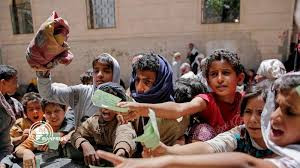
SANAA, Aug. 29 (Saba) - Yemen usually imports more than 90% of staple food. But a naval embargo imposed by the Saudi-led coalition, fighting around the Hadi government-controlled port of Aden and air strikes on the port of Hudaydah, have severely reduced imports since 2015.
A lack of fuel, coupled with insecurity and damage to markets and roads, have also prevented supplies from being distributed.
Basic commodity prices are on average 30 to 50% higher than before the war, while purchasing power has been substantially reduced because of dwindling livelihoods.
The restrictions on imports of fuel - essential for maintaining the water supply - combined with damage to pumps and sewage treatment facilities, also mean that 14.4 million people now lack access to safe drinking water or sanitation, including 8.2 million who are in acute need.
People have been forced to rely on untreated water supplies and unprotected wells, placing them at risk of life-threatening illnesses. An outbreak of cholera and acute watery diarrhoea was declared in October. As of March 2017, a total of 22,181 suspected cases of cholera and 103 associated deaths had been reported.
Agriculture use alone consumes 90% of Yemen’s water, so if agriculture can use water more efficiently there would be more water for urban consumption. And if water withdrawals are regulated and limited, aquifers will recharge at rates varying with local geology.
The vast majority of water in Yemen is a renewable natural resource whose source is the rain.
The cost from damage to infrastructure and economic losses in Yemen’s war is more than $14 billion so far, according to a confidential report seen by Reuters that highlights the effort needed to rebuild the country, where more than half the population is suffering from malnutrition.
“The conflict has so far resulted in damage costs (still partial and incomplete) of almost $7 billion and economic losses (in nominal terms) of over $7.3 billion in relation to production and service delivery,” said the May 6 joint report by the World Bank, United Nations, Islamic Development Bank and European Union.
The Preliminary Damage and Needs Assessment report is an internal working document that is not being publicly released.
"These preliminary findings are not only partial, but also evolving" because the war is ongoing, the report said. The assessment, it said, was conducted between late 2015 and early this year.
The risk of economic insolvency remains high. Indicators of such an outcome are the following: the Central Bank of Yemen has hemorrhaged through its reserves17, import and tax revenue have been crippled by conflict, the Yemeni riyal continues to fall against the dollar and the official rate, and the cost of basic goods has increased due to limits on imports and public sector wages depended on by more than one million Yemenis have remained unpaid . With few resources, little trade access and a bloated public sector.
M.M